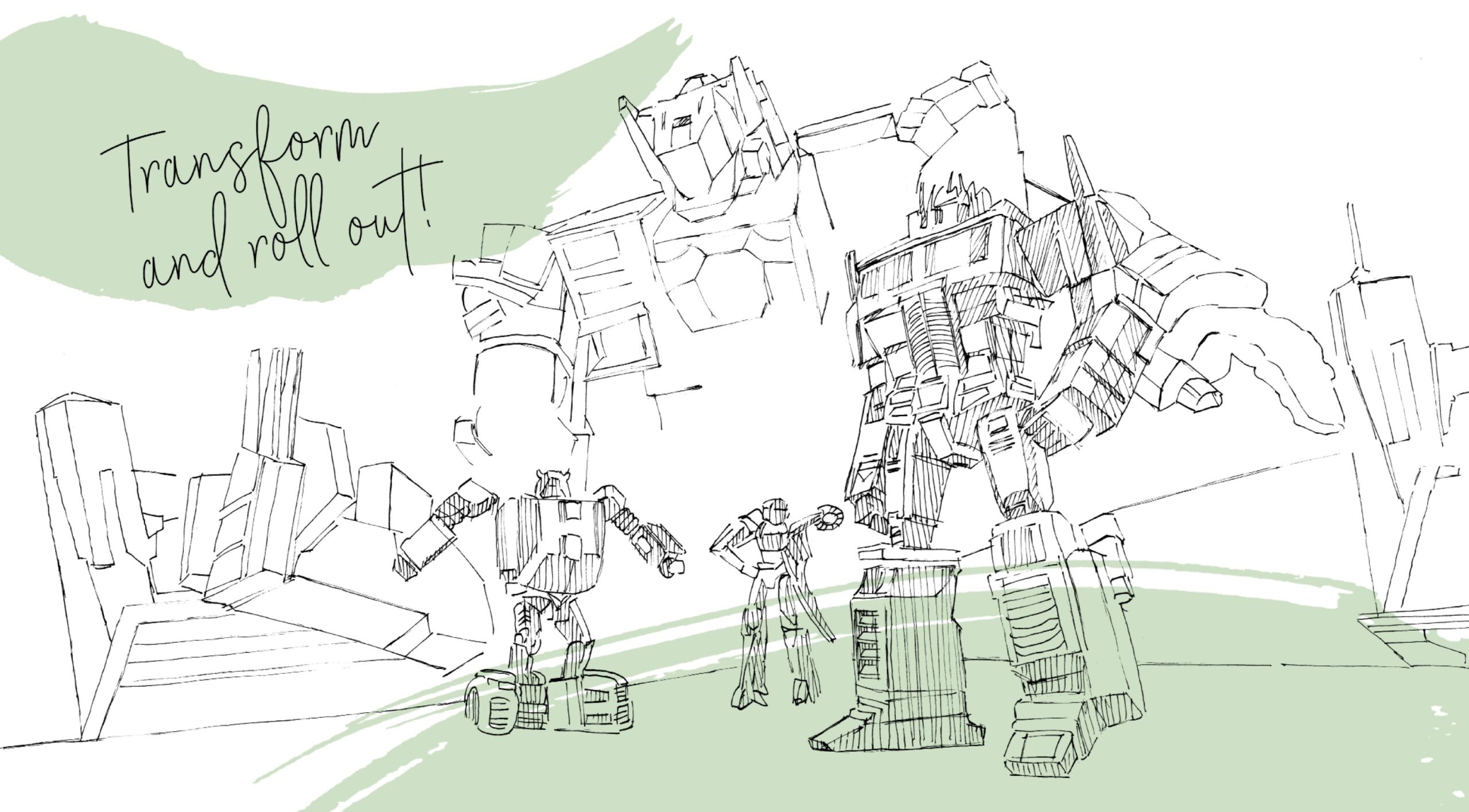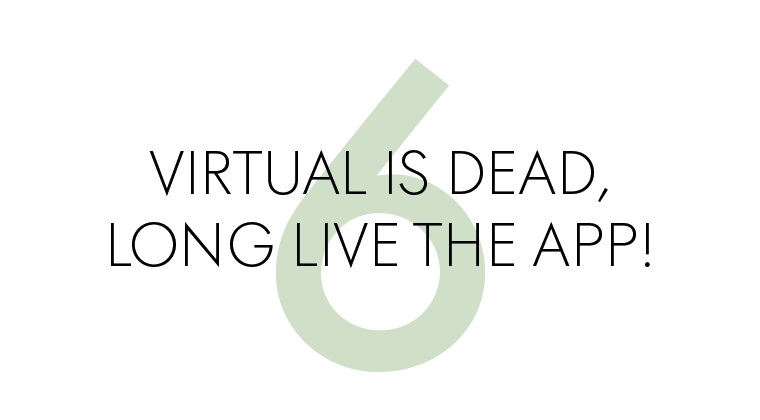Transform and rollout!
Have you heard of “Transformers”, the successful film and toy franchise? Those vehicles that turn into giant robots as you turn the steering wheel? “Transform and roll out!” !” – the official battle cry of these Autobots – could also be the motto for your digital strategy.

We talked to scenographer Charlotte Tamschick and digital consultant Florian Rotberg to find out why. Together, they answer the seven most pressing questions: Which technologies best support our stores, which are damp squibs and why is multimedia now the best way to showcase products?
conclusions: Numerous possibilities already exist to create an emotional ambience and deploy guided selling – from tracking passers-by at shop windows to fully automated price displays. In these times of coronavirus, digital technologies also help to maintain distance to products and to other visitors.

Charlotte Tamschick (Partner and Creative Director at Tamschick Media+Space, Berlin)
Charlotte Tamschick believes that retail spaces can work like exciting exhibitions. A scenographer since 1998, she likes to let the objects speak and to embed them in immersive experiences. TAMSCHICK MEDIA+SPACE is one of the leading international studios for media scenography. It conceptualises and produces media in space, as well as facade installations, for international museums, exhibitions and world expositions.
Florian Rotberg (Owner of Invidis Consulting, Munich & Managing Director of the Digital Signage Summit Europe)
He is convinced that retailers have not yet recognised or tapped the potential harboured by digital technologies. In view of this, and also because he likes to look to the future, Florian Rotberg acts as a competent intermediary between technology companies and retailers. His company invidis consulting is one of Europe’s leading consultancies for digital signage and digital out-of-home advertising.
1. DIGITAL PROMOTES ADAPTABILITY.
FR There are many reasons to use digital media in the store. The most important is its adaptability: to customers, times of day or collections. At the click of a mouse, I can simultaneously adjust content, launch a campaign or change prices, whether on a single floor space or worldwide, and thus avoid losses due to incorrectly labelled goods.
CT This flexibility also pays off for the scenography: You can update digital content in line with the season and situation without having to convert the whole room. You can create an immersive experience without having to build a colosseum first.
2. DIGITALITY IS A JOINT PROJECT.
FR Once an application is digital, it needs live data and has to be connected to your merchandise and customer management systems. Customers expect all digital content – from guidance systems through to price tags – to be up to date and this requires all departments to work together!
The visitor experience thrives on a holistic approach to communication. Charlotte Tamschick
CT And this approach is needed not only when systems are up and running, but during development already. Sadly, digital is sometimes treated merely as a special effect or as an add-on for a finished concept. And yet the visitor experience thrives on a holistic approach to communication. To achieve this, you have to get planners and designers from all areas involved right from the start.
FR That is a challenge for multi-brand stores. Brands develop their visual concepts to function the same way all over the world. This approach works when the brands are presented on their own, but not when they have to share the same space with a hundred other brands. That is why we are often overwhelmed, especially in beauty departments, by multisensual stimuli, both analogue and digital. Store operators hold the key to solving this problem. Department stores have to see themselves as product range designers once again and set out holistic concepts for multimedia as well.
3. THE STORE ITSELF BECOMES A TRANSFORMER.
CT At museums, there is a trend towards to creating different routes or discovery paths for different age and target groups. I do not think much of that. Like rooms and exhibitions, stores should also be designed to work well for the widest possible group.
FR That is why we believe in the adaptive store. Physical retail will only survive if stores learn to adapt to customers. Why do luxury brands invest in good salespeople and put a greeter at the entrance? They note the gender, age and style of visitors to the store and immediately adjust in order to provide individual and sensitive advice. We can extend this experience across all segments by deploying analysis technology. Sensors transmit their data to the back-end and the store technology automatically adjusts the lighting, music, guidance systems and product information.
4. WE LIKE IT INDIVIDUAL AND INVISIBLE.
CT That’s something I find really exciting. We could simply adjust the whole ambience based on presence and movement, without anyone actually pressing any switches. Based on our observations, technology aimed at promoting interaction actually creates greater distances if it is visible. It’s very important to make sure that the boundaries between visitors and the theme world they enter are as seamless as possible.
Personalization based on facial recognition is a no-go. Florian Rotberg
FR It will even be possible for sensors to detect my mood. We’ve already experimented with eye-tracking solutions, which have been well received. By contrast, personalization based on facial recognition is a no-go. Customers like it individual, but not too personal.
5. SHOPPING MEANS IMMERSING YOURSELF.
FR We have already accompanied ambience control along these lines in a duty free shop at an international airport. There, the shop always knows exactly which city the last plane came from and adapts the lighting, scent and music to the new arrivals. A shop in a pedestrian zone would have to find other ways to cluster its clientele.
CT If we manage that, then we can create entire shopping dramaturgies with product presentations that even react to individual visitors. This way, retailers too can tell stories in which visitors can immerse themselves with all their senses. One example: walk-through visual and audio passages such as those we have already created at some museums.
FR Surveys show that customers want a lot of background information: about the brand, product features, materials or ingredients and the ideas and principles that motivate the company. This information is really important, especially for the Fridays for Future generation.
CT It’s a similar picture in museums, which is why we integrate objects into their cultural and historical contexts. I can exhibit a vase, but I can also show the room in which it stood and the lives of the people who lived in that room. The retail industry can learn something from this context-bound presentation. Show the emotions behind the product. Reveal its soul. Breathe life into the inanimate object.
6. VIRTUAL IS DEAD, LONG LIVE THE APP!

FR In retail, experiments are already underway here with augmented reality (AR), both to provide information and to create small stories that project you into the product context. Holograms and 3D screens, on the other hand, are tricky because they are made for a long stay in the store. And virtual reality is usually too intrusive for the advice process, as you move between worlds when you put on or remove the glasses.
CT That’s why AR is so interesting. It maintains a reference to reality and works from all perspectives – or actually always from your own perspective.
FR The main challenge is that you need an app and actually installing this still presents a great hurdle.
CT But that will change. We are already winning numerous competitions with museum concepts, all of which include an app that you have to install before you visit the museum. Why shouldn’t that also work in retail, especially when some shopping trips are already planned in advance, just like a visit to a gallery?…
7. DIGITAL MAKES SOCIAL.
FR …and is staged as such! A large fast fashion provider has converted and enlarged fitting rooms at its stores so that you can book them with your whole group of friends for a specific time. The fitting room becomes a stage, and shopping a party, all supported by a few customizable multimedia features. It’s a social experience – and that’s what make it a huge success.
CT I think shops could be even more experimental when it comes to trying out playful formats suitable to their specific segment. In our museum projects, we were even able to communicate complex political topics to young audiences by enabling visitors to act out the key roles.
FR During the coronavirus pandemic, but also when it is over, we just need to make sure that everything works with greater distances. According to a survey conducted in the travel retail segment, 62 percent of customers are reducing their contact to staff due to the risk of infection.
CT The experience can already begin outdoors, such as in front of the shop window. That is where I see the greatest potential for retailers to tell multimedia stories and draw attention to their products – with music, moving images, and – it goes without saying – online links. Here, individuals can be addressed in the real world. Via the online community, they are then connected to a group experience and can overcome the physical boundaries we currently face. This way, we can also preserve shopping as a social experience.